Emotions Evoked by Colors and Health Functionality Information of Colored Rice: A Cross-Cultural Study
Abstract
1. Introduction
2. Materials and Methods
2.1. Experimental Design
2.2. Stimuli
2.3. Test 1: Development of Emotion Lexicons
2.3.1. Identifying Emotions
Participants
Data Collection Outline
Data Analysis
2.3.2. Selecting Terms
The First Consumer Test
2.4. Test 2: Emotional Response
The Second Consumer Test
2.5. Data Analysis
3. Results and Discussion
3.1. Test 1: Development of Emotion Lexicons
3.1.1. Identifying Emotions
3.1.2. Selecting Emotion Lexicons
3.2. Test 2: Emotional Response
3.2.1. Overall Liking and Familiarity
3.2.2. Classification of the Emotion Lexicon
3.2.3. Emotion Profiles
4. General Discussion and Conclusion
Supplementary Materials
Author Contributions
Funding
Institutional Review Board Statement
Informed Consent Statement
Data Availability Statement
Acknowledgments
Conflicts of Interest
References
- Zampini, M.; Sanabria, D.; Philips, N.; Spence, C. The multisensory perception of flavor: Assessing the influence of color cues on flavor discrimination responses. Food Qual. Prefer. 2007, 18, 975–984. [Google Scholar] [CrossRef]
- Gilbert, A.N.; Fridlund, A.J.; Lucchina, L.A. The color of emotion: A metric for implicit color associations. Food Qual. Prefer. 2016, 52, 203–210. [Google Scholar] [CrossRef]
- Shankar, M.U.; Levitan, C.A.; Spence, C. Grape expectations: The role of cognitive influences in color-flavor interactions. Conscious. Cogn. 2010, 19, 380–390. [Google Scholar] [CrossRef] [PubMed]
- Piqueras-Fiszman, B.; Jaeger, S.R. The effect of product—Context appropriateness on emotion associations in evoked eating occasions. Food Qual. Prefer. 2015, 40, 49–60. [Google Scholar] [CrossRef]
- Spinelli, S.; Masi, C.; Zoboli, C.P.; Prescott, J.; Monteleone, E. Emotional responses to branded and unbranded foods. Food Qual. Prefer. 2015, 42, 1–11. [Google Scholar] [CrossRef]
- Olson, J.C.; Jacoby, J. Cue utilization in the quality perception process. In SV—Proceedings of the Third Annual Conference of the Association for Consumer Research; Venkatesan, M., Ed.; Association for Consumer Research: Chicago, IL, USA, 1972; pp. 169–179. [Google Scholar]
- Tuorila, H.; Cardello, A.V. Consumer responses to off-flavor in juice in the presence of specific health claims. Food Qual. Prefer. 2002, 13, 561–569. [Google Scholar] [CrossRef]
- Hoefkens, C.; Verbeke, W.; Van Camp, J.V. European consumers’ perceived importance of qualifying and disqualifying nutrients in food choices. Food Qual. Prefer. 2011, 22, 550–558. [Google Scholar] [CrossRef]
- Lagerkvist, C.J.; Okello, J.; Muoki, P.; Heck, S.; Prain, G. Nutrition promotion messages: The effect of information on consumer sensory expectations, experiences and emotions of vitamin A-biofortified sweet potato. Food Qual. Prefer. 2016, 52, 143–152. [Google Scholar] [CrossRef]
- Jiang, Y.; King, J.M.; Prinyawiwatkul, W. A review of measurement and relationships between food, eating behavior and emotion. Trends Food Sci. Technol. 2014, 36, 15–28. [Google Scholar] [CrossRef]
- Coppin, G.; Sander, D. Theoretical approaches to emotion and its measurement emotion measurement. In Emotion Measurement; Woodhead Publishing: Cambridge, UK, 2016; pp. 3–30. [Google Scholar]
- Merlo, T.C.; Soletti, I.; Saldaña, E.; Menegali, B.S.; Martins, M.M.; Teixeira, A.C.B.; Harada-Padermo, S.D.S.; Dargelio, M.D.B.; Contreras-Carstillo, C.J. Measuring dynamics of emotions evoked by the packaging colour of hamburgers using Temporal Dominance of Emotions (TDE). Food Res. Int. 2019, 124, 147–155. [Google Scholar] [CrossRef]
- Spinelli, S.; Jaeger, S.R. What do we know about the sensory drives of emotions in foods and beverages? Curr. Opin. Food Sci. 2019, 27, 82–89. [Google Scholar] [CrossRef]
- Bagozzi, R.P.; Pieters, R. Goal-directed emotions. Cogn. Emot. 1998, 12, 1–26. [Google Scholar] [CrossRef]
- Spinelli, S.; Niedziela, M. Emotion measurements and application to product and packaging development. In Integrating the Packaging and Product Experience in Food and Beverages; Woodhead Publishing: Cambridge, UK, 2016; pp. 77–119. [Google Scholar]
- Gutjar, S.; Graaf, C.; Kooijman, V.; Wijk, R.A.; Nys, A.; Horst, G.J.; Jager, G. The role of emotions in food choice and liking. Food Res. Int. 2015, 76, 216–223. [Google Scholar] [CrossRef]
- Cardello, A.V.; Meiselman, H.L.; Schutz, H.G.; Craig, C.; Given, Z.; Lesher, L.L.; Eicher, S. Measuring emotional responses to foods and food names using questionnaires. Food Qual. Prefer. 2012, 24, 243–250. [Google Scholar] [CrossRef]
- Jaeger, S.R.; Hedderley, D.I. Impact of individual differences in emotional intensity and private body consciousness on EsSense Profile® responses. Food Qual. Prefer. 2013, 27, 54–62. [Google Scholar] [CrossRef]
- King, S.C.; Meiselman, H.L.; Carr, B.T. Measuring emotions associated with foods in consumer testing. Food Qual. Prefer. 2010, 21, 1114–1116. [Google Scholar] [CrossRef]
- King, S.C.; Meiselman, H.L.; Carr, B.T. Measuring emotions associated with foods: Important elements of questionnaire and test design. Food Qual. Prefer. 2013, 28, 8–16. [Google Scholar] [CrossRef]
- Ng, M.; Chaya, C.; Hort, J. Beyond liking: Comparing the measurement of emotional response using EsSense Profile® and consumer defined check-all-that-apply methodologies. Food Qual. Prefer. 2013, 28, 193–205. [Google Scholar] [CrossRef]
- Thomson, D.M.H. SensoEmotional optimization of food products and brands. In Consumer-Led Food Product Development; Woodhead Publishing Ltd.: Cambridge, UK, 2007. [Google Scholar]
- Desmet, P.M.A.; Schifferstein, H.N.J. Sources of positive and negative emotions in food experience. Appetite 2008, 50, 290–301. [Google Scholar] [CrossRef]
- Porcherot, C.; Delplanque, S.; Raviot-Derrien, S.; Le Calvé, B.; Chrea, C.; Gaudreau, N.; Cayeux, I. How do you feel when you smell this? Optimization of a verbal measurement of odor-elicited emotions. Food Qual. Prefer. 2010, 21, 938–947. [Google Scholar] [CrossRef]
- King, S.C.; Meiselman, H.L. Development of a method to measure consumer emotions associated with foods. Food Qual. Prefer. 2010, 21, 168–177. [Google Scholar] [CrossRef]
- Chrea, C.; Grandjean, D.; Delplanque, S.; Cayeux, I.; Le Calvé, B.; Aymard, L.; Velazco, M.I.; Sander, D.; Klaus, R. SchererMapping the semantic space for the subjective experience of emotional responses to odors. Chem. Senses 2009, 34, 49–62. [Google Scholar] [CrossRef] [PubMed]
- Spinelli, S.; Masi, C.; Dinnella, C.; Zoboli, G.P.; Monteleone, D. How does it make you feel? A new approach to measuring emotions in food product experience. Food Qual. Prefer. 2014, 37, 109–122. [Google Scholar] [CrossRef]
- Schouteten, J.J.; Steur, H.D.; Pelsmaeker, S.D.; Lagast, S.; Juvinal, J.G.; Bourdeaudhuij, I.D.; Verbeke, W.; Gellynck, X. Emotional and sensory profiling of insect-, plant-, and meat-based burgers under blind, expected and informed conditions. Food Qual. Prefer. 2016, 52, 27–31. [Google Scholar] [CrossRef]
- Schlich, P. Temporal Dominance of Sensation (TDS): A new deal for temporal sensory analysis. Curr. Opin. Food Sci. 2017, 15, 38–42. [Google Scholar] [CrossRef]
- Bhumiratana, B.; Adhikari, K.; Chambers, E. The development of an emotion lexicon for the coffee drinking experience. Food Res. Int. 2014, 61, 83–92. [Google Scholar] [CrossRef]
- Hu, X.; Lee, J. Emotions elicited while drinking coffee: A cross-cultural comparison between Korean and Chinese consumers. Food Qual. Prefer. 2019, 76, 160–168. [Google Scholar] [CrossRef]
- Ferrarini, R.; Carbognin, C.; Casarotti, E.M.; Nicolis, E.; Nencini, A.; Meneghini, A.M. The emotional response to wine consumption. Food Qual. Prefer. 2010, 21, 720–725. [Google Scholar] [CrossRef]
- Chaya, C.; Eaton, C.; Hewson, L.; Vázquezc, R.F.; Fernández-Ruiz, V.; Smart, K.A.; Hort, J. Developing a reduced consumer-led lexicon to measure emotional response to beer. Food Qual. Prefer. 2015, 45, 100–112. [Google Scholar] [CrossRef]
- Thomson, D.M.H.; Crocker, C.; Marketo, C.G. Linking sensory characteristics to emotions: An example using dark chocolate. Food Qual. Prefer. 2010, 21, 1117–1125. [Google Scholar] [CrossRef]
- Zyl, H.V.; Meiselman, H.L. The roles of language in designing emotion lists: Comparing the same language in different English and Spanish speaking countries. Food Qual. Prefer. 2015, 41, 201–213. [Google Scholar]
- Zyl, H.V.; Meiselman, H.L. An update on the roles of culture and language in designing emotion lists: English, Spanish and Portuguese. Food Qual. Prefer. 2016, 51, 72–76. [Google Scholar]
- Chataigner, J. Simultaneous growth and diversification of rice consumption in Europe and the USA. In Proceedings of the Prospects for Rice Consumption in Europe Symposium, Verona, Italy, 24 October 1992. [Google Scholar]
- Suwansri, S.; Meullenet, J.F.; Hankins, J.A.; Griffin, K. Preference mapping of domestic/imported Jasmine rice for U.S.-Asian consumers. J. Food Sci. 2002, 67, 2420–2431. [Google Scholar] [CrossRef]
- Son, J.S.; Do, V.B.; Kim, K.O.; Cho, M.S.; Suwonsichon, T.; Valentin, D. Understanding the effect of culture on food representations using word associations: The case of “rice” and “good rice”. Food Qual. Prefer. 2014, 31, 38–48. [Google Scholar]
- FAOSTAT (2016). FAO Online Database. Available online: http://www.fao.org/corp/statistics/ (accessed on 1 November 2016).
- Sumczynski, D.; Kotásková, E.; Družbíková, H.; Mlček, J. Determination of contents and antioxidant activity of free and bound phenolics compounds and in vito digestibility of commercial black and red rice (Oryza sativa L.) varieties. Food Chem. 2016, 211, 339–346. [Google Scholar] [CrossRef] [PubMed]
- Color-Coated Rice Ready for Market. Taipei Times, 21 May 2013. Available online: http://www.taipeitimes.com/News/taiwan/archives/2013/05/21/2003562813 (accessed on 5 December 2020).
- Natural-Colored Food Satisfying Taste, Visual Appeal, and Health. Financial News, 23 December 2010. Available online: http://www.fnnews.com/news/201012231427176985?t=y (accessed on 11 November 2016).
- Palamanit, A.; Soponronnarit, S.; Prachayawarakorn, S.; Tungtrakul, P. Qualities of turmeric extract coated rice using top-spray fluidized bed coating technique. In Proceedings of the 7th Asia-Pacific Drying Conference Tianjin 2011, Tianjin, China, 18–20 September 2011. [Google Scholar]
- Piqueras-Fiszman, B.; Jaeger, S.R. The impact of evoked consumption contexts and appropriateness on emotion responses. Food Qual. Prefer. 2014, 32, 277–288. [Google Scholar] [CrossRef]
- Piqueras-Fiszman, B.; Jaeger, S.R. Emotion responses under evoked consumption contexts: A focus on the consumers” frequency of product consumption and the stability of responses. Food Qual. Prefer. 2014, 35, 24–31. [Google Scholar] [CrossRef]
- Piqueras-Fiszman, B.; Spence, C. Sensory expectations based on product-extrinsic food cues: An interdisciplinary review of the empirical evidence and theoretical accounts. Food Qual. Prefer. 2015, 40, 165–179. [Google Scholar]
- Zhou, X.; Wan, X.; Mu, B.; Du, D.; Spence, C. Crossmodal associations and subjective ratings of Asian noodles and the impact of the receptacle. Food Qual. Prefer. 2015, 41, 141–150. [Google Scholar] [CrossRef]
- Penton®. 2016. Available online: https://www.pantone.com/color-finder (accessed on 1 December 2016).
- Kim, I.H.; Han, K.S. Research and study on analysis of food color on each food product. J. Korean Soc. Des. Sci. 2007, 20, 353–364. [Google Scholar]
- Kim, S.W.; Lee, Y.R. What Is Beauty? -The Aesthetic Cognition of Korean Women in Their 20s and 30s-. J. Consum. Stud. 2012, 23, 315–382. [Google Scholar]
- Silverman, D. Doing Qualitative Research: A Practical Handbook, 2nd ed.; Sage: Thousand Oaks, CA, USA, 2005. [Google Scholar]
- Meiselman, H.L. A review of the current state of emotion research in product development. Food Res. Int. 2015, 76, 192–199. [Google Scholar] [CrossRef]
- Laros, F.J.M.; Steenkamp, J.-B.E.M. Emotions in consumer behavior: A hierarchical approach. J. Bus. Res. 2005, 58, 1437–1445. [Google Scholar] [CrossRef]
- Kuesten, K.; Chopra, P.; Bi, J.; Meiselman, H.L. A global study using PANAS (PA and NA) scales to measure consumer emotions associated with aromas of phytonutrient supplements. Food Qual. Prefer. 2014, 33, 86–97. [Google Scholar] [CrossRef]
- McNair, D.M.; Lorr, M.; Droppleman, L.F. Profile of Mood States; Educational and Industrial Testing Service: San Diego, CA, USA, 1971. [Google Scholar]
- Zuckerman, M.; Lubin, B. Manual for the Multiple Affect Adjective Check List; Educational and Industrial Testing Service: San Diego, CA, USA, 1965. [Google Scholar]
- Cohen, J. Statistical power analysis for the behavioral sciences. In Statistical Power Analysis for the Behavioral Sciences; Lawrence Erlbaum Associates, INC.: Hillsdale, NJ, USA, 1977. [Google Scholar]
- Ferdnzi, C.; Schirmer, A.; Robert, S.C.; Delplanque, S.; Porcherit, C.; Cayeux, I.; Velazco, M.-I.; Sander, D.; Scherer, K.R.; Grandjean, D. Affect dimensions of ordor perception: A comparison between Swiss, British, and Singaporean populations. Emotion 2011, 11, 1168. [Google Scholar]
- Russell, J.A. A circumflex model of affect. J. Personal. Soc. Psychol. 1980, 39, 1161–1178. [Google Scholar] [CrossRef]
- Watson, D.; Tellegen, A. Toward a consensual structure of mood. Psychol. Bull. 1985, 98, 219–235. [Google Scholar] [CrossRef]
- Spinelli, S.; Monteleone, E.; Ares, G.; Jaeger, S.R. Sensory drivers of product-elicited emotions are moderated by liking: Insights from consumer segmentation. Food Qual. Prefer. 2019, 7, 103725. [Google Scholar] [CrossRef]
- Keith, J.F.; Stastny, S.; Brunt, A.; Agnew, W. Barriers and strategies for healthy food choices among American Indian tribal college students: A qualitative analysis. J. Acad. Nutr. Diet. 2018, 118, 1017–1026. [Google Scholar] [CrossRef]
- Gibson, E.L. Emotional influences on food choice: Sensory, physiological and psychological pathways. Physiol. Behav. 2006, 89, 53–61. [Google Scholar] [CrossRef]
- Colchamiro, R.; Ghiringhelli, K.; Hause, J. Touching hearts, touching minds: Using emotion-based messaging to promote healthful behavior in the Massachusetts WIC program. J. Nutr. Educ. Behav. 2010, 42, S59–S65. [Google Scholar] [CrossRef] [PubMed]
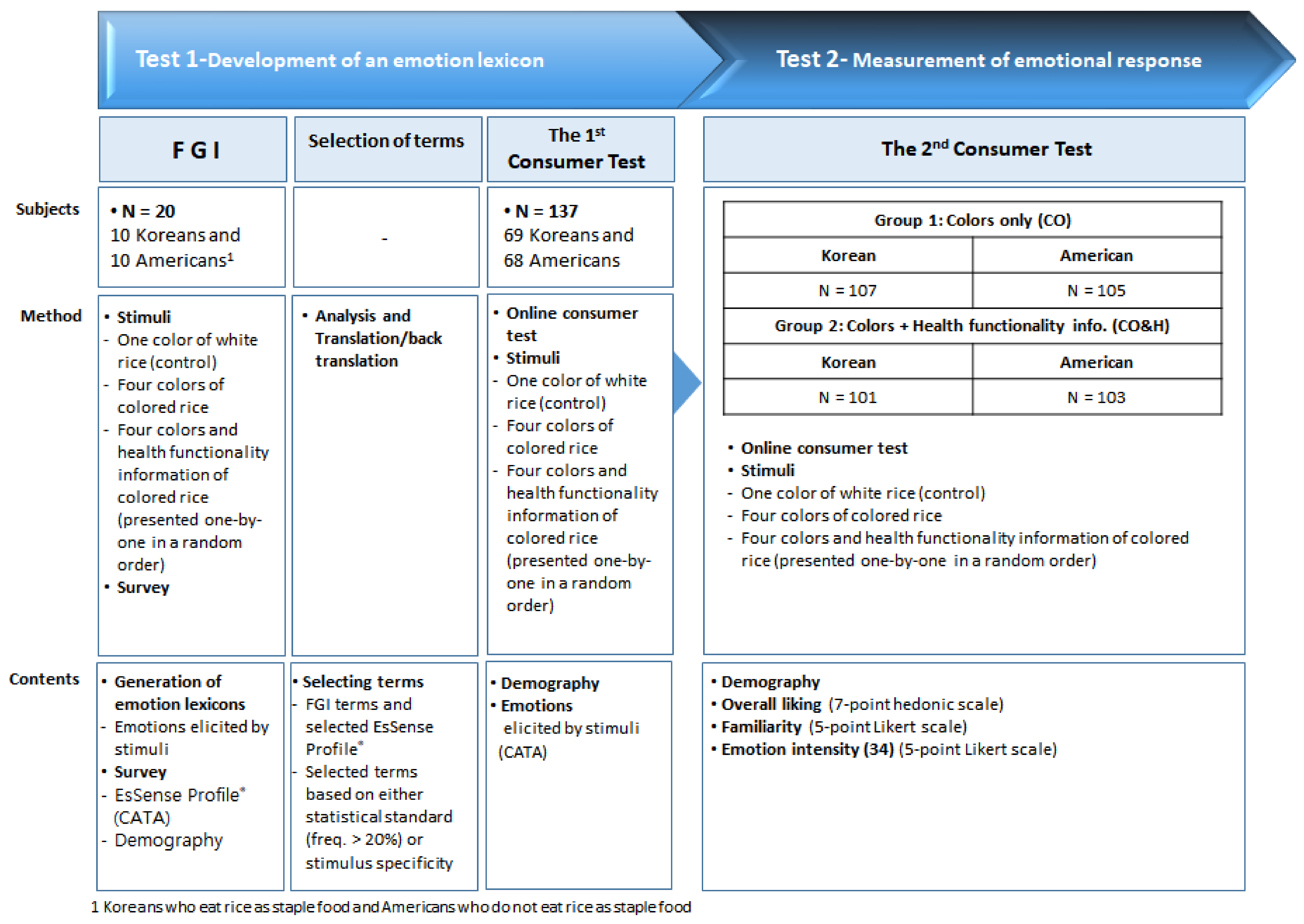
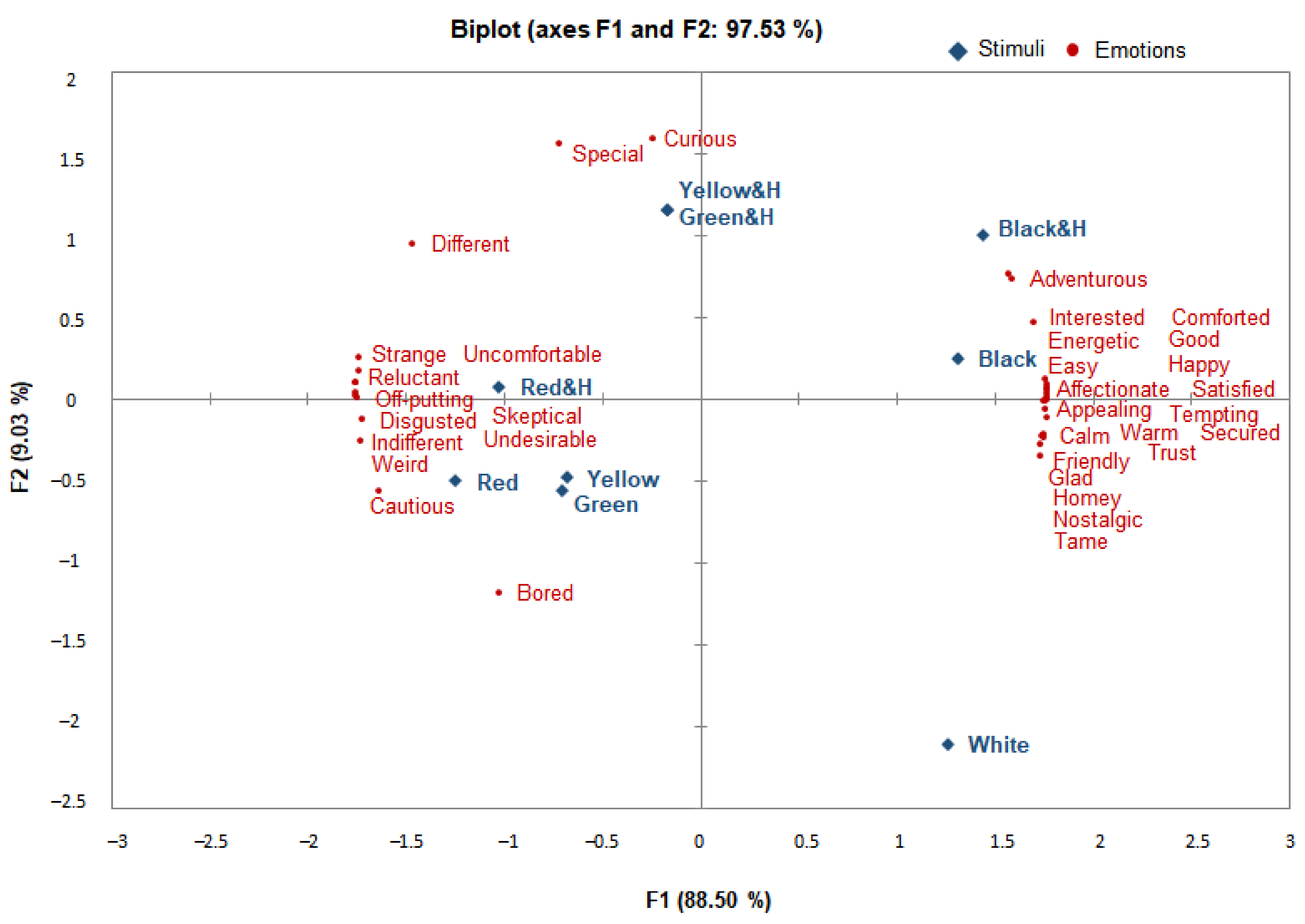
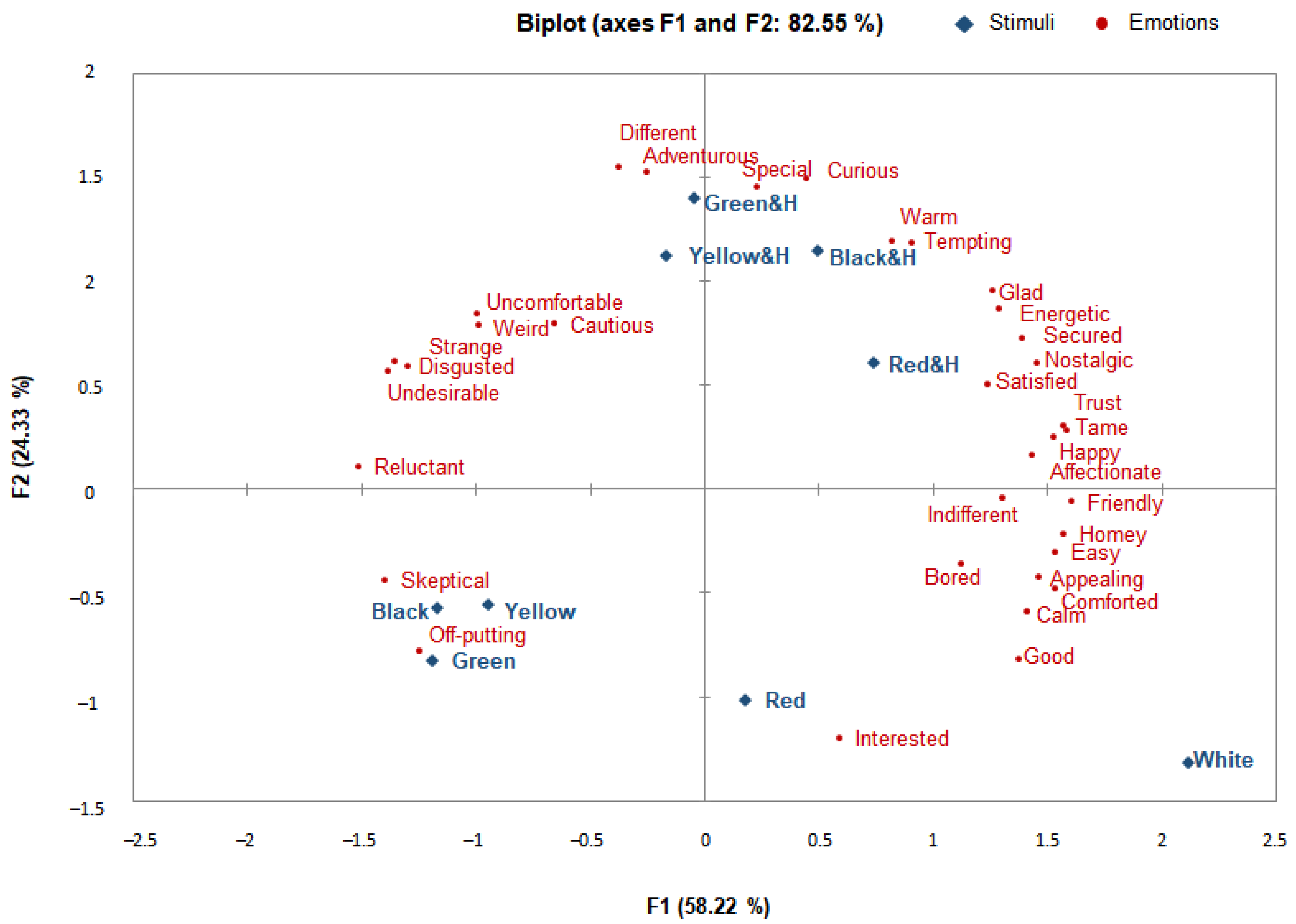
| Colors | Images | Ingredients and Health Functionality Information |
|---|---|---|
| White (control) | 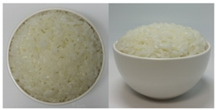 | - |
| Yellow | 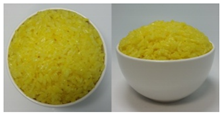 | * Ingredients: • Short-grain white rice (Korea, pesticide-free), 33.47% • Powdered Curcuma, 0.013% • Water-soluble curcumin, 0.008% * Curcuma aromatica Slab. • Curcuma is originally from India and belongs to the ginger family. Since ancient times, Curcuma has been used as a spice, as a folk medicine for inflammation and skin problems, and as a coloring agent. • Curcuminoid, the main pigment in Curcuma, is known to inhibit cholesterol, arteriosclerosis, and inflammation. In addition, it has been reported that it is effective for various physiological activities and that it has anticancer, antioxidant, and anti-inflammatory effects. |
| Green | 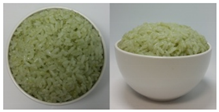 | * Ingredients: • Short-grain white rice (Korea, pesticide-free), 33.46% • Powdered Chlorella, 0.024% * Chlorella • Chlorella is a kind of freshwater green algae and an excellent source of essential amino acids. It contains minerals including calcium, magnesium, iron, and zinc and vitamins such as inositol, niacin, ascorbic acid, carotene, and pyridoxine and is commonly used as a health food. • The Chlorella growth factor (CFG) contained in Chlorella is a biological active substance and is well-known for its bioactive functions, such as promoting growth in children, lowering cholesterol, and lowering blood pressure. |
| Red |  | * Ingredients: • Short-grain white rice (Korea, pesticide-free), 33.47% • Powdered Monascus (Korean, total monacolin K, 0.4%), 0.01% * Red yeast • Red yeast rice is made by inoculating and cultivating Monascus perpereus in steamed rice. It has been used not only as a food, but also for coloring and taste enhancement of fermented foods such as alcohol for centuries in China. It is also famous for its effectiveness in promoting digestion and blood circulation. • The red pigment in red yeast rice has an anti-inflammatory effect and monacolin K has a cholesterol-lowering effect. |
| Black | 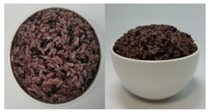 | * Ingredients: • Short-grain white rice (Korea, pesticide-free), 28.27% • Short-grain black rice, 5.23% * Black rice • Black rice is a kind of colored rice. Since it is unpolished rice, it is high in dietary fibers, vitamins, and minerals. • Since black rice contains bioactive substances including polyphenols, flavonoids, anthocyanins, and γ-oryzanol, it is known for its antioxidant effects. • Anthocyanin, a pigment in the bran of black rice, is reported to have antibacterial, antimutagenic, thrombolytic, and anti-aging effects and also acts as an antioxidant. |
| English | Korean | English | Korean | English | Korean |
|---|---|---|---|---|---|
| Adventurous 1,2 | 도전해보고 싶은 + | Expectant + | 기대되는 + | Satisfied + | 만족스러운 + |
| Affectionate + | 정성이 느껴지는 + | Free + | 자유로운 + | Scared – | 무서운 – |
| Aggressive u | 자극적인 u | Friendly + | 친근한 + | Secure + | 안심할수있는 + |
| Appealing + | 호감이 가는 + | Funny + | 재미있는 + | Skeptical – | 의심스러운 – |
| Bored – | 지루한 – | Glad + | 반가운 + | Special + | 특별한 + |
| Calm + | 진정되는 + | Good + | 좋은 + | Steady u | 질리지않는 u |
| Cautious – | 조심스러운 – | Guilty – | 죄책감이드는 – | Strange – | 이질감이드는 – |
| Comfortable + | 편안한 + | Happy + | 행복한 + | Stressful – | 스트레스가생기는 – |
| Comforted + | 위안이 되는 + | Homey + | 집같은편안한 + | Tame u | 평범한 u |
| Confused – | 헷갈리는 – | Indifferent u | 그저그런 u | Tempting + | 구미가당기는 + |
| Curious + | 호기심이 생기는 + | Insecure – | 불안한 – | Tender + | 부드러운 + |
| Daring u | 과감한 u | Interested + | 관심이생기는 + | Trust + | 신뢰감이드는 + |
| Different u | 색다른 u | Joyful + | 기쁜 + | Uncomfortable – | 부담스러운 – |
| Disappointed – | 실망스러운 – | Loving + | 사랑스러운 + | Understanding u | 이해되는 u |
| Disgusted – | 혐오스러운 – | Melancholic – | 우울한 – | Undesirable – | 원하지않는 – |
| Eager u | 간절히 원하는 u | Mild u | 순한 u | Warm + | 따뜻한 + |
| Easy + | 부담스럽지 않은 + | Nostalgic u | 향수가느껴지는 u | Weird – | 이상한 – |
| Energetic + | 에너지가 느껴지는 + | Off-putting – | 거부감이드는 – | Whole + | 온전한 + |
| Enthusiastic + | 열정이 생기는 + | Polite u | 고상한 u | Wild u | 날것의 u |
| Excited + | 신나는 + | Reluctant – | 주저하게되는 – | Worried – | 걱정되는 – |
| English | Korean | English | Korean | English | Korean |
|---|---|---|---|---|---|
| Adventurous 1 | 도전해보고 싶은 | Friendly | 친근한 | Skeptical | 의심스러운 |
| Affectionate | 정성이 느껴지는 | Glad | 반가운 | Special | 특별한 |
| Appealing | 호감이 가는 | Good | 좋은 | Strange | 이질감이 드는 |
| Bored | 지루한 | Happy | 행복한 | Tame | 평범한 |
| Calm | 진정되는 | Homey | 집밥 같은 편안한 | Tempting | 구미가 당기는 |
| Cautious | 조심스러운 | Indifferent | 그저 그런 | Trust | 신뢰감이 드는 |
| Comforted | 위안이 되는 | Interested | 관심이 생기는 | Uncomfortable | 부담스러운 |
| Curious | 호기심이 생기는 | Nostalgic | 향수가 느껴지는 | Undesirable | 원하지 않는 |
| Different | 색다른 | Off-putting | 거부감이 드는 | Warm | 따뜻한 |
| Disgusted | 혐오스러운 | Reluctant | 주저하게 되는 | Weird | 이상한 |
| Easy | 부담스럽지 않은 | Satisfied | 만족스러운 | ||
| Energetic | 에너지가 느껴지는 | Secure | 안심할 수 있는 |
| White | Yellow | Green | Red | Black | F value | ||
|---|---|---|---|---|---|---|---|
| Koreans | CO | 4.95 ± 1.14 d | 3.28 ± 1.30 b | 3.28 ± 1.47 b | 2.47 ± 1.29 a | 5.32 ± 1.07 d | 99.23 *** |
| CO&H | 5.20 ± 1.06 d | 3.91 ± 1.37 c | 3.51 ± 1.29 b | 2.82 ± 1.33 a | 5.43 ± 1.18 d | 80.38 *** | |
| t value | −1.6 | −3.4 ** | −1.17 | −1.9 | −0.76 | - | |
| Americans | CO | 5.09 ± 1.28 c | 4.26 ± 1.54 b | 3.61 ± 1.72 a | 3.74 ± 1.73 a | 3.60 ± 1.69 a | 16.45 *** |
| CO&H | 5.02 ± 1.20 c | 4.09 ± 1.62 b | 3.38 ± 1.64 a | 3.44 ± 1.60 a | 3.82 ± 1.71 a,b | 18.61 *** | |
| t value | 0.39 | 0.77 | 0.99 | 1.33 | −0.92 | - |
| White | Yellow | Green | Red | Black | F Value | ||
|---|---|---|---|---|---|---|---|
| Koreans | CO | 3.87 ± 0.95 c | 1.88 ± 1.06 b | 1.94 ± 1.08 b | 1.34 ± 0.93 a | 3.9 ± 50.79 c | 219.77 *** |
| CO&H | 4.01 ± 0.79 d | 2.29 ± 1.25 c | 1.94 ± 0.98 b | 1.34 ± 0.84 a | 4.08 ± 0.76 d | 206.35 *** | |
| t value | −1.2 | −2.55 | −0.01 | 0.42 | −1.24 | - | |
| Americans | CO | 3.56 ± 1.04 c | 2.61 ± 1.27 b | 2.18 ± 1.27 a | 2.20 ± 1.35 a | 2.27 ± 1.31 a,b | 39.79 *** |
| CO&H | 3.61 ± 0.99 d | 2.30 ± 1.29 c | 1.84 ± 1.12 a,b | 1.63 ± 1.21 a | 2.07 ± 1.27 b,c | 65.93 *** | |
| t value | −0.39 | 1.79 | 2.01 * | 3.19 ** | 1.15 | - |
| Emotion | Koreans | Emotion | Americans |
|---|---|---|---|
| Adventurous N | 0.471 *** | Adventurous N | 0.082 ** |
| Curious N | 0.106 ** | Curious N | 0.123 *** |
| Different N | –0.366 *** | Different N | –0.140 *** |
| Interested N | 0.426 *** | Interested N | 0.344 *** |
| Special N | –0.061 * | Special + | 0.288 *** |
| Affectionate + | 0.684 *** | Affectionate + | 0.409 *** |
| Appealing + | 0.735 *** | Appealing + | 0.568 *** |
| Calm + | 0.687 *** | Calm + | 0.450 *** |
| Comforted + | 0.694 *** | Comforted + | 0.562 *** |
| Easy + | 0.545 *** | Easy + | 0.477 *** |
| Energetic + | 0.531 *** | Energetic + | 0.342 *** |
| Friendly + | 0.844 *** | Friendly + | 0.478 *** |
| Glad + | 0.783 *** | Glad + | 0.448 *** |
| Good + | 0.749 *** | Good + | 0.519 *** |
| Happy + | 0.726 *** | Happy + | 0.461 *** |
| Homey + | 0.807 *** | Homey + | 0.491 *** |
| Nostalgic + | 0.709 *** | Nostalgic + | 0.467 *** |
| Satisfied + | 0.732 *** | Satisfied + | 0.530 *** |
| Secured + | 0.712 *** | Secured + | 0.444 *** |
| Tame + | 0.672 *** | Tame + | 0.562 *** |
| Tempting + | 0.683 *** | Tempting + | 0.451 *** |
| Trust + | 0.672 *** | Trust + | 0.471 *** |
| Warm + | 0.661 *** | Warm + | 0.458 *** |
| Bored – | –0.104 *** | Bored – | 0.137 *** |
| Cautious – | –0.211 *** | Cautious – | 0.022 |
| Disgusted – | –0.493 *** | Disgusted – | –0.136 *** |
| Indifferent – | –0.304 *** | Indifferent – | 0.227 *** |
| Off-putting – | –0.604 *** | Off-putting – | –0.102 ** |
| Reluctant – | –0.654 *** | Reluctant – | –0.170 *** |
| Skeptical – | –0.609 *** | Skeptical – | –0.205 *** |
| Strange – | –0.653 *** | Strange – | –0.247 *** |
| Uncomfortable – | –0.592 *** | Uncomfortable – | –0.178 *** |
| Undesirable – | –0.604 *** | Undesirable – | –0.180 *** |
| Weird – | −0.681 *** | Weird – | −0.271 *** |
| Koreans | Americans | ||||
|---|---|---|---|---|---|
| Cluster 1 | Cluster 2 | Cluster 3 | Cluster 1 | Cluster 2 | Cluster 3 |
| “New” | “Positive” | “Negative” | “New” | “Positive” | “Negative” |
| Adventurous | Affectionate | Bored | Adventurous | Affectionate | Bored |
| Curious | Appealing | Cautious | Curious | Appealing | Cautious |
| Different | Calm | Disgusted | Different | Calm | Disgusted |
| Interested | Comforted | Indifferent | Interested | Comforted | Indifferent |
| Special | Easy | Off-putting | Easy | Off-putting | |
| Energetic | Reluctant | Energetic | Reluctant | ||
| Friendly | Skeptical | Friendly | Skeptical | ||
| Glad | Strange | Glad | Strange | ||
| Good | Uncomfortable | Good | Uncomfortable | ||
| Happy | Undesirable | Happy | Undesirable | ||
| Homey | Weird | Homey | Weird | ||
| Nostalgic | Nostalgic | ||||
| Satisfied | Satisfied | ||||
| Secured | Secured | ||||
| Tame | Special | ||||
| Tempting | Tame | ||||
| Trust | Tempting | ||||
| Warm | Trust | ||||
| Warm | |||||
| 5 | 18 | 11 | 4 | 19 | 11 |
| Emotions | Koreans | Emotions | Americans |
|---|---|---|---|
| Adventurous N | 0.61 *** | Adventurous N | 0.28 *** |
| Curious N | 0.28 *** | Curious N | 0.35 *** |
| Different N | −0.21 *** | Different N | 0 |
| Interested N | 0.55 *** | Interested N | 0.57 *** |
| Special N | 0.10 *** | Special + | 0.43 *** |
| Affectionate + | 0.77 *** | Affectionate + | 0.50 *** |
| Appealing + | 0.80 *** | Appealing + | 0.74 *** |
| Calm + | 0.71 *** | Calm + | 0.51 *** |
| Comforted + | 0.72 *** | Comforted + | 0.64 *** |
| Easy + | 0.57 *** | Easy + | 0.53 *** |
| Energetic + | 0.63 *** | Energetic + | 0.48 *** |
| Friendly + | 0.80 *** | Friendly + | 0.60 *** |
| Glad + | 0.78 *** | Glad + | 0.58 *** |
| Good + | 0.78 *** | Good + | 0.68 *** |
| Happy + | 0.78 *** | Happy + | 0.61 *** |
| Homey + | 0.79 *** | Homey + | 0.59 *** |
| Nostalgic + | 0.68 *** | Nostalgic + | 0.45 *** |
| Satisfied + | 0.78 *** | Satisfied + | 0.68 *** |
| Secured + | 0.75 *** | Secured + | 0.55 *** |
| Tame + | 0.61 *** | Tame + | 0.61 *** |
| Tempting + | 0.76 *** | Tempting + | 0.64 *** |
| Trust + | 0.73 *** | Trust + | 0.61 *** |
| Warm + | 0.70 *** | Warm + | 0.57 *** |
| Bored − | –0.19 *** | Bored – | –0.02 |
| Cautious − | –0.21 *** | Cautious – | –0.04 |
| Disgusted − | –0.55 *** | Disgusted – | –0.32 *** |
| Indifferent − | –0.35 *** | Indifferent – | 0.15 *** |
| Off-putting − | –0.64 *** | Off-putting – | –0.24 *** |
| Reluctant − | –0.67 *** | Reluctant – | –0.28 *** |
| Skeptical − | –0.62 *** | Skeptical – | –0.27 *** |
| Strange − | –0.63 *** | Strange – | –0.28 *** |
| Uncomfortable − | –0.61 *** | Uncomfortable – | –0.31 *** |
| Undesirable − | –0.66 *** | Undesirable – | –0.35 *** |
| Weird − | −0.67 *** | Weird – | −0.33 *** |
Publisher’s Note: MDPI stays neutral with regard to jurisdictional claims in published maps and institutional affiliations. |
© 2021 by the authors. Licensee MDPI, Basel, Switzerland. This article is an open access article distributed under the terms and conditions of the Creative Commons Attribution (CC BY) license (http://creativecommons.org/licenses/by/4.0/).
Share and Cite
Jang, J.A.; Oh, J.E.; Na, Y.; Yeo, G.E.; Cho, M.S. Emotions Evoked by Colors and Health Functionality Information of Colored Rice: A Cross-Cultural Study. Foods 2021, 10, 231. https://doi.org/10.3390/foods10020231
Jang JA, Oh JE, Na Y, Yeo GE, Cho MS. Emotions Evoked by Colors and Health Functionality Information of Colored Rice: A Cross-Cultural Study. Foods. 2021; 10(2):231. https://doi.org/10.3390/foods10020231
Chicago/Turabian StyleJang, Jin A, Ji Eun Oh, Yeseul Na, Ga Eun Yeo, and Mi Sook Cho. 2021. "Emotions Evoked by Colors and Health Functionality Information of Colored Rice: A Cross-Cultural Study" Foods 10, no. 2: 231. https://doi.org/10.3390/foods10020231
APA StyleJang, J. A., Oh, J. E., Na, Y., Yeo, G. E., & Cho, M. S. (2021). Emotions Evoked by Colors and Health Functionality Information of Colored Rice: A Cross-Cultural Study. Foods, 10(2), 231. https://doi.org/10.3390/foods10020231






